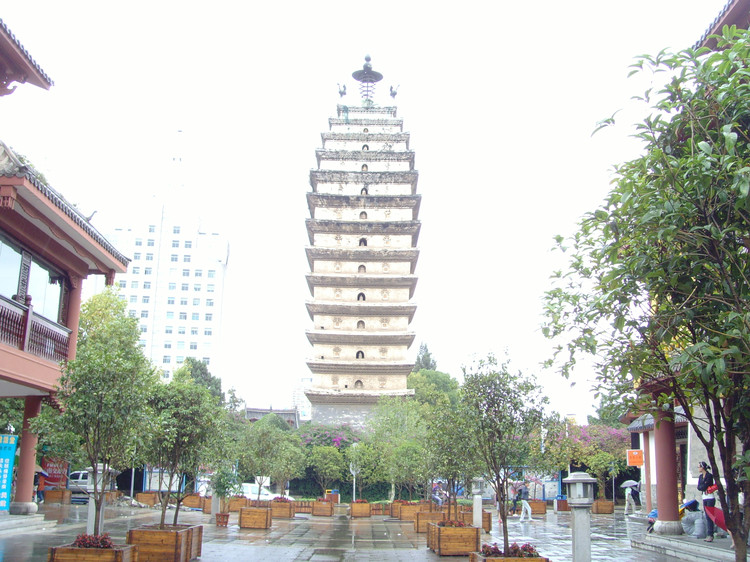
In the ancient city of Kunming stand two ancient pagodas, one in the east and the other in the west. West Pagoda used to be located in the now nonexistent Huiguang Temple. The temple used to be called West Temple, so the pagoda was named West Temple Pagoda. Now only the pagoda remains.

Historical records show that both the temple and the pagoda were built between 824 and 859 in the Tang Dynasty. In appearance and structure the pagoda resembles Small, Wild Goose Pagoda in Xi'an. The square, thirteen-storey, rnulti-eave pagoda is some thirty-six meters high. Its interior is hollow, with wooden flooring and a staircase. The bricks of the pagoda are inscribed with Buddhist scriptures and incantations in Chinese and Sanskrit and the stamps of brickmakers, all invaluable relics. The pagoda has undergone repairs several times over the past more than a thousand years, so some parts have been changed, but as a whole it has retained its Tang Dynasty style.

East Temple Pagoda used to be in Changle Temple on Shulin Street in Kunming City. Changle Temple was also called East Temple, thus the pagoda's name. According to historical records, the temple and pagoda were built at the same time as the West Temple and Pagoda, but the pagoda was destroyed in a strong earthquake in 1833. In 1882 it was rebuilt on a new site hundreds of steps east of its original location, which lay too low for the pagoda's foundation. The existing pagoda, a multi-eave, square, thirteen-storey, brick structure, dates back to 1882 during the Qing Dynasty. In appearance, structure and size it resembles the West Pagoda. Although it was rebuilt in the Qing Dynasty, it retains the style of the Tang Dynasty.
History
The Eastern and Western Pagodas of Kunming, are located in the south of the city comprised of two pagodas rising up in close proximity to one another. The Pagoda of the West Temple (Xisi Ta) and the Pagoda of the East Temple (Dongsi Ta), both date from the Tang period (618-907) and both have been faithfully rebuilt in 1901 after the Muslim uprising of 1868.
In 1901, Kunming - then known as Yunnanfu- was the established center of power for Yunnan which was part of the sphere of influence of the waning Qing Dynasty.
But Kunming had not always been a part of the Chinese empire though, as is evidenced by the presence of these two Bai-style pagodas built when the city was called Tuodong and was not administered by Han Chinese, but by the Bai and Yi kingdom known as Nanzhao. The pagodas are some of the oldest standing structures in Kunming.
While China was flourishing under the Tang Dynasty (618-907) the Nanzhao Kingdom emerged as a major regional force for a relatively short time, during which it controlled all of Yunnan. From defeating the Tang army at Xiaguan in 751 until its conquest of Chengdu in 829, the Nanzhao Kingdom experienced nearly 80 years of rapid expansion, resulting in a kingdom that ruled all of Yunnan, most of Sichuan and much of northern Myanmar, Thailand and Laos.
During this time, the Nanzhao Kingdom built the Eastern and Western Pagodas in an area south of Kunming's city wall. The pagodas were positioned in a way that mirrored the Dade Temple Twin Pagodas, which were within the city wall and are still standing today. The Twin Pagodas are hidden in a small alley one kilometer to the north between Huashan Dong Lu and Qingnian Lu.
The Eastern and Western Pagodas were both constructed more than 11 centuries ago. A great earthquake during the Yuan Dynasty (1271–1368) toppled the Eastern Pagoda, which was rebuilt shortly afterward. Thus, the Western Pagoda is in actuality several centuries older than its counterpart.
Admission Fee:¥0

You will only receive emails that you permitted upon submission and your email address will never be shared with any third parties without your express permission.
